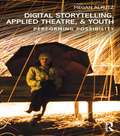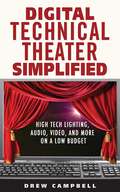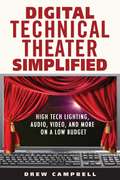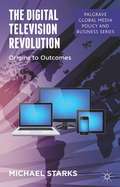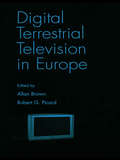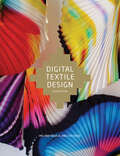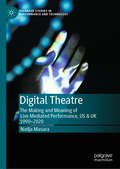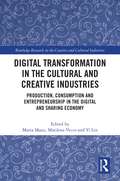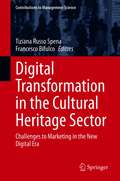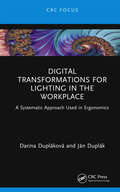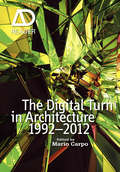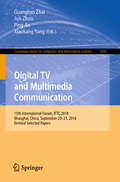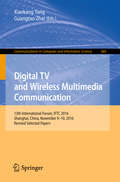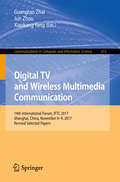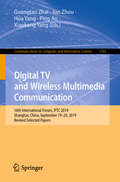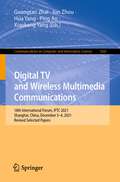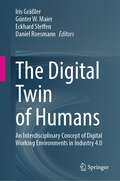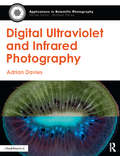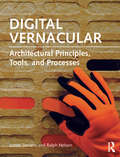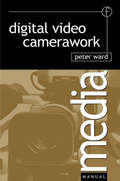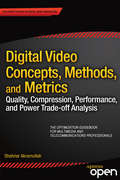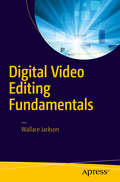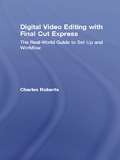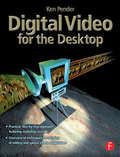- Table View
- List View
Digital Storytelling, Applied Theatre, & Youth: Performing Possibility
by Megan AlrutzDigital Storytelling, Applied Theatre, & Youth argues that theatre artists must re-imagine how and why they facilitate performance practices with young people. Rapid globalization and advances in media and technology continue to change the ways that people engage with and understand the world around them. Drawing on pedagogical, aesthetic, and theoretical threads of applied theatre and media practices, this book presents practitioners, scholars, and educators with innovative approaches to devising and performing digital stories. This book offers the first comprehensive examination of digital storytelling as an applied theatre practice. Alrutz explores how participatory and mediated performance practices can engage the wisdom and experience of youth; build knowledge about self, others and society; and invite dialogue and deliberation with audiences. In doing so, she theorizes digital storytelling as a site of possibility for critical and relational practices, feminist performance pedagogies, and alliance building with young people.
Digital Technical Theater Simplified: High Tech Lighting, Audio, Video and More on a Low Budget
by Drew CampbellThe theater is in the midst of a digital revolution! This book provides readers with an easy-to-understand overview of the digital technology currently available for the stage. In clear language, Digital Technical Theater Simplified explains digital technology in the fields of lighting, audio, video, and show control. All chapters contain do-it-yourself examples of how anyone can use these advanced technologies, as well as case studies of "How the Pros Do It."
Digital Technical Theater Simplified: High Tech Lighting, Audio, Video and More on a Low Budget
by Drew CampbellThe theater is in the midst of a digital revolution! This book provides readers with an easy-to-understand overview of the digital technology currently available for the stage. In clear language, Digital Technical Theater Simplified explains digital technology in the fields of lighting, audio, video, and show control. All chapters contain do-it-yourself examples of how anyone can use these advanced technologies, as well as case studies of #147;How the Pros Do It. ”
The Digital Television Revolution: Origins To Outcomes (Palgrave Global Media Policy and Business)
by Michael StarksThis account of the global switch to digital television, from its origins to its emerging outcomes, provides an understanding of how digital television is converging with the Internet. It pictures a future in which the democratic role of the media, freedom of expression and democratic participation can be enhanced.
Digital Terrestrial Television in Europe
by Allan Brown Robert G. PicardDigital technology for the production, transmission, and reception of television is expected to replace analogue transmission throughout the world. The timetable for this transition is uncertain and different projections have been made for virtually every country in the world. This book gives the exhaustive details of the issues of this changeover in Europe and elsewhere. The details are placed within the context of the massive changes, which the television industry has been subjected to over the past 25 years.The rollout of digital terrestrial television (DTTV) in Europe is a significant issue for every country included in this survey. It is of such importance because DTTV is the centerpiece of many governments' policies toward making Europe the world leader in new information and communication technologies. These same governments are all wrestling with the issues of how to use the technology in ways that create both commercial and non-commercial value. European perspectives on the social, cultural, and political nature of broadcasting vary significantly from those in other parts of the world and require that the introduction of DTTV should be handled differently to its introduction elsewhere.There are enormous technical, political, and economic aspects to be considered and these vary from country to country in Europe. The two editors bring a perspective to this study as media economists who come to the European scene from other parts of the world. The book covers DTTV in depth, and it also includes discussions of cable, satellite, broadband, and Internet technology for comparison.
Digital Textile Design, Second edition
by Melanie BowlesDigital Textile Design, Second Edition covers everything students and practitioners of textile design will need to learn about designing and printing digitally. Written specifically for textile designers, Digital Textile Design, Second Edition provides the know-how for students and professionals who wish to use Adobe Photoshop and Illustrator as design tools. A series of inspirational tutorials, presented in step-by-step format, guide the reader through the process of creating designs that will be suited to both the traditional textile production process and to digital printing onto fabric.The book examines how designers can access the techniques of digital textile printing, looking at the work of those currently exploring its possibilities, and provides an insight into the technology involved. With a stunning new design, this edition has been updated in line with the latest developments in Adobe Creative Suite and contains new images throughout.
Digital Textile Design Second Edition
by Ceri Isaac Melanie BowlesDigital Textile Design, Second Edition covers everything students and practitioners of textile design will need to learn about designing and printing digitally. Written specifically for textile designers, Digital Textile Design, Second Edition provides the know-how for students and professionals who wish to use Adobe Photoshop and Illustrator as design tools. A series of inspirational tutorials, presented in step-by-step format, guide the reader through the process of creating designs that will be suited to both the traditional textile production process and to digital printing onto fabric.The book examines how designers can access the techniques of digital textile printing, looking at the work of those currently exploring its possibilities, and provides an insight into the technology involved. With a stunning new design, this edition has been updated in line with the latest developments in Adobe Creative Suite and contains new images throughout.
Digital Theatre: The Making and Meaning of Live Mediated Performance, US & UK 1990-2020 (Palgrave Studies in Performance and Technology)
by Nadja MasuraDigital Theatre is a rich and varied art form evolving between performing bodies gathered together in shared space and the ever-expanding flexible reach of the digital technology that shapes our world. This book explores live theatre performances which incorporate video projection, animation, motion capture and triggering, telematics and multisite performance, robotics, VR, and AR. Through examples from practitioners like George Coates, the Gertrude Stein Repertory Theatre, Troika Ranch, David Saltz, Mark Reaney, The Builder’s Association, and ArtGrid, a picture emerges of how and why digital technology can be used to effectively create theatre productions matching the storytelling and expressive needs of today’s artists and audiences. It also examines how theatre roles such as director, actor, playwright, costumes, and set are altered, and how ideas of body, place, and community are expanded.
Digital Transformation in the Cultural and Creative Industries: Production, Consumption and Entrepreneurship in the Digital and Sharing Economy (Routledge Research in the Creative and Cultural Industries)
by Marta Massi, Marilena Vecco and Yi LinThis research-based book investigates the effects of digital transformation on the cultural and creative sectors. Through cases and examples, the book examines how artists and art institutions are facing the challenges posed by digital transformation, highlighting both positive and negative effects of the phenomenon. With contributions from an international range of scholars, the book examines how digital transformation is changing the way the arts are produced and consumed. As relative late adopters of digital technologies, the arts organizations are shown to be struggling to adapt, as issues of authenticity, legitimacy, control, trust, and co-creation arise. Leveraging a variety of research approaches, the book identifies managerial implications to render a collection that is valuable reading for scholars involved with arts and culture management, the creative industries and digital transformation more broadly.
Digital Transformation in the Cultural Heritage Sector: Challenges to Marketing in the New Digital Era (Contributions to Management Science)
by Tiziana Russo Spena Francesco BifulcoThis book devises an alternative conceptual framework to understand digital transformation in the cultural heritage sector. It achieves this by placing a high importance on the role of technology in the strategic process of modeling and developing cultural services in the digital era. The focus is on how marketing activities and customer processes are being transformed by digital technologies to create better value, which can also be communicated to customers through an engaged and personalized approach. Much of the digital debate in cultural heritage is still in infancy. Some existing studies are anecdotal and often developed within the domain of established research streams, including studies with some technological aspects addressed partially and from an episodic or periodic perspective. Moreover, the critical changes that have emerged in the cultural management landscape are yet to be highlighted. This book fills that gap and provides a perspective on the cultural heritage sector, which uses the new social and technology landscape to describe the digital transformation in cultural heritage sectors. The authors highlight an inclusive perspective that addresses marketing strategy in the digital era as a proactive, technology-enabled process by which firms collaborate with customers to jointly create, communicate, deliver, and sustain experience and value co-creation.
Digital Transformations for Lighting in the Workplace: A Systematic Approach Used in Ergonomics
by Darina Dupláková Ján DuplákDigital Transformations for Lighting in the Workplace: A Systematic Approach Used in Ergonomics offers a practical concept for the implementation of digital transformation in ergonomics in work settings. It specifically focuses on providing information about illumination in production and non-production fields, and the described design solutions are applicable in practice. The concepts can be used in a typical manufacturing workplace or an academic setting. The methods in the book complement the modern trend to digitalise the workplace, making the research and practical outcomes of this book compatible with the concept of Industry 4.0 - Digital Manufacturing. This title offers a systematic approach to the field of digital transformation for ergonomics. It presents an opportunity for the reader to learn to create a digital model for lighting by analysing mathematical models for calculation through formulas and simulation algorithms. To put learning into context, this book provides two case studies from the production and non-production sectors, including an example of a classroom. The reader will then be able to utilise the methods to create their own digitized illumination system. This monograph is an ideal read for academics and researchers working at universities in the field of Ergonomics and professionals in industrial management including those in manufacturing plants, ergonomists, designers from the industry sector, or people who are interested in ergonomics, digitization, and simulation of a working environment.
The Digital Turn in Architecture 1992 - 2012 (AD Reader)
by Mario CarpoNow almost 20 years old, the digital turn in architecture has already gone through several stages and phases. Architectural Design (AD) has captured them all – from folding to cyberspace, nonlinearity and hypersurfaces, from versioning to scripting, emergence, information modelling and parametricism. It has recorded and interpreted the spirit of the times with vivid documentary precision, fostering and often anticipating crucial architectural and theoretical developments. This anthology of AD’s most salient articles is chronologically and thematically arranged to provide a complete historical timeline of the recent rise to pre-eminence of computer-based design and production. Mario Carpo provides an astute overview of the recent history of digital design in his comprehensive introductory essay and in his leaders to each original text. A much needed pedagogical and research tool for students and scholars, this synopsis also relates the present state of digitality in architecture to the history and theory of its recent development and trends, and raises issues of crucial importance for the contemporary practice of the design professions. A comprehensive anthology on digital architecture edited by one of its most eminent scholars in this field, Mario Carpo. Includes seminal texts by Bernard Cache, Peter Eisenman, John Frazer, Charles Jencks, Greg Lynn, Achim Menges and Patrik Schumacher. Features key works by FOA, Frank Gehry, Zaha Hadid, Ali Rahim, Lars Spuybroek/NOX, Kas Oosterhuis and SHoP.
Digital TV and Multimedia Communication: 15th International Forum, IFTC 2018, Shanghai, China, September 20–21, 2018, Revised Selected Papers (Communications in Computer and Information Science #1009)
by Guangtao Zhai Jun Zhou Ping An Xiaokang YangThis book presents revised selected papers from the 15th International Forum on Digital TV and Multimedia Communication, IFTC 2018, held in Shanghai, China, in September 2018.The 39 full papers presented in this volume were carefully reviewed and selected from 130 submissions. They were organized in topical sections on image processing; machine learning; quality assessment; telecommunications; video coding; video surveillance; virtual reality.
Digital TV and Wireless Multimedia Communication
by Xiaokang Yang Guangtao ZhaiThis book constitutes the refereed proceedings of the 13th International Forum of Digital TV and Wireless Multimedia Communication, IFTC 2016, held in Shanghai, China, in November 2016. The 38 revised full papers presented were carefully reviewed and selected from 102 submissions. The papers are organized in topical sections on image processing; audio processing; image and video compression; telecommunications.
Digital TV and Wireless Multimedia Communication
by Guangtao Zhai Jun Zhou Xiaokang YangThis book presents revised selected papers from the 14th International Forum on Digital TV and Wireless Multimedia Communication, IFTC 2017, held in Shanghai, China, in November 2017. The 46 papers presented in this volume were carefully reviewed and selected from 122 submissions. They were organized in topical sections named: image processing; machine learning; quality assessment; social media; telecommunications; video surveillance; virtual reality; computer vision; and image compression.
Digital TV and Wireless Multimedia Communication: 16th International Forum, IFTC 2019, Shanghai, China, September 19–20, 2019, Revised Selected Papers (Communications in Computer and Information Science #1181)
by Jun Zhou Xiaokang Yang Guangtao Zhai Ping An Hua YangThis book presents revised selected papers from the 16th International Forum on Digital TV and Wireless Multimedia Communication, IFTC 2019, held in Shanghai, China, in September 2019.The 34 full papers presented in this volume were carefully reviewed and selected from 120 submissions. They were organized in topical sections on image processing; machine learning; quality assessment; telecommunications; video surveillance; virtual reality.
Digital TV and Wireless Multimedia Communications: 18th International Forum, IFTC 2021, Shanghai, China, December 3–4, 2021, Revised Selected Papers (Communications in Computer and Information Science #1560)
by Guangtao Zhai Jun Zhou Hua Yang Ping An Xiaokang YangThis book presents revised selected papers from the 18th International Forum on Digital TV and Wireless Multimedia Communication, IFTC 2021, held in Shanghai, China, in December 2021.The 41 papers presented in this volume were carefully reviewed and selected from 110 submissions. They were organized in topical sections on image analysis; quality assessment; target detection; video processing; big data.
The Digital Twin of Humans: An Interdisciplinary Concept of Digital Working Environments in Industry 4.0
by Iris Gräßler Günter W. Maier Eckhard Steffen Daniel RoesmannThis book provides an interdisciplinary concept of digital working environments in industry 4.0 to enable the implementation of the digital twin of humans.Information and communication technology is penetrating all areas of daily life at a rapid pace in private and professional areas. These technologies enable companies to aggregate huge volumes of data. Collected personal data of employees creates the opportunity of a digital representation of the human being itself, that is conformant with the definition of a digital twin. These digital twins of humans include selected characteristics and behaviour of the humans, that are linked to models, information, and data. According to existing trend studies, the digital twin of humans is a technology that will have a significant impact on the economy, society, and people. It is important to consider the regulatory framework for the use of personal data and threats of misuse.This book will be of use to researchers and professionals in industry.
Digital Ultraviolet and Infrared Photography (Applications in Scientific Photography)
by Adrian DaviesDigital Ultraviolet and Infrared Photography discusses the growing number of applications of ultraviolet and infrared photography. Scientific and technical photographers, such as those engaged in scientific, medical, forensic, and landscape and wildlife photography routinely use ultraviolet and infrared techniques, and these techniques are growing in use in creative photography. This is the first book to address the application and potential for both ultraviolet and infrared photography in both science and art. The author, Adrian Davies, discusses the how-to of ultraviolet and infrared digital recording with a dissection of techniques, camera requirements and camera conversion, a useful appendix of resources and equipment currently available and inspirational image examples throughout. Digital Ultraviolet and Infrared Photography is an essential read for photographers using these tools either professionally or creatively.
Digital Vernacular: Architectural Principles, Tools, and Processes
by James Stevens Ralph NelsonDigital Vernacular addresses the why and how of digital fabrication in hundreds of step-by-step color images, illuminating a set of working principles and techniques that join theory with practice. Authors James Stevens and Ralph Nelson reconcile local traditions and innovations with globally accessible methods and digital toolsets. By combining ethics with hardware, the book will root you in the origins of making, ensuring a lasting and relevant reference for your studio practice. The book opens with the origins and principles of the digital vernacular, then outlines digital vernacular tools including computer numerically controlled (CNC) mills, laser cutters, and 3D printers. You'll even learn to create your own digital fabrication tools out of inexpensive materials. The book concludes with the processes of the digital vernacular, including techniques for removing, joining, forming, and adding. A companion website at make-Lab.org hosts additional step-by-step processes and project outcomes.
Digital Video Camerawork (Media Manuals Ser.)
by Peter WardThis manual introduces digital camerawork techniques used in television and video production. Written as a practical guide, the author's step-by-step instructions take you through everything you need to know, from camera controls, to editing, lighting and sound. This text provides a solid foundation to build upon in the area of digital video production. In a period of transition between analogue and digital acquisition/recording formats Digital Video Camerawork provides up-to-date information familiarizing you with the different production styles and requirements. Diagrams are used to illustrate the technology and techniques explained.Digital Video Camerawork combines clear, technical explanations with practical advice. It is ideal for the less experienced broadcast camera operator and for students on media and television production courses.
Digital Video Concepts, Methods, and Metrics: Quality, Compression, Performance, and Power Trade-off Analysis
by Shahriar AkramullahDigital Video Concepts, Methods, and Metrics: Quality, Compression, Performance, and Power Trade-off Analysis is a concise reference for professionals in a wide range of applications and vocations. It focuses on giving the reader mastery over the concepts, methods and metrics of digital video coding, so that readers have sufficient understanding to choose and tune coding parameters for optimum results that would suit their particular needs for quality, compression, speed and power. The practical aspects are many: Uploading video to the Internet is only the beginning of a trend where a consumer controls video quality and speed by trading off various other factors. Open source and proprietary applications such as video e-mail, private party content generation, editing and archiving, and cloud asset management would give further control to the end-user. Digital video is frequently compressed and coded for easier storage and transmission. This process involves visual quality loss due to typical data compression techniques and requires use of high performance computing systems. A careful balance between the amount of compression, the visual quality loss and the coding speed is necessary to keep the total system cost down, while delivering a good user experience for various video applications. At the same time, power consumption optimizations are also essential to get the job done on inexpensive consumer platforms. Trade-offs can be made among these factors, and relevant considerations are particularly important in resource-constrained low power devices. To better understand the trade-offs this book discusses a comprehensive set of engineering principles, strategies, methods and metrics. It also exposes readers to approaches on how to differentiate and rank video coding solutions. What you'll learn Cost-benefit analysis of compression techniques Video quality metrics evaluation Performance and power optimization and measurement Trade-off analysis among power, performance, and visual quality Emerging uses and applications of video technologies Who this book is for This book is for anyone involved in designing, developing, validating, deploying, and reviewing systems and applications that deal with digital video. For example, software and hardware engineers, system architects, technical program and product managers, support and sales engineers, system integrators, technology journalists and video professionals working in the multimedia and telecommunication industries, researchers and graduate students, or even a tech-savvy user who posts a YouTube video would find this book a useful reference. Table of Contents Foreword/Preface Chapter 1:Introduction Chapter 2: Digital Video Compression Techniques Chapter 3: Video Coding Standards Chapter 4: Video Quality Metrics Chapter 5: Video Coding Speed and Performance Chapter 6: Power Consumptions by Video Applications Chapter 7: Video Application Power Consumption on Low-Power Platforms Chapter 8: Performance, Power, and Quality Tradeoff Analysis Chapter 9: Conclusion Appendix: Related Resources
Digital Video Editing Fundamentals
by Wallace JacksonThis compact visual guide covers concepts central to digital video using the affordable Corel Video Studio Ultimate X9 software package as well as open source digital video editing package Editshare Lightworks 12. Digital Video Editing Fundamentals builds on the essential concepts of digital imaging, audio, illustration, and painting, and gets more advanced as chapters progress, covering what digital video new media formats are best for use with Android Studio, Java and JavaFX, iOS and HTML5. Furthermore, the author covers the key factors regarding the data footprint optimization work process, streaming versus captive assets, and why these are important. What you'll learn What is the terminology of digital video editing and special effects What comprises a digital video editing and effects pipeline What are the concepts behind digital video editing What are the concepts behind Resolution, Aspect Ratio, Bit Rate and Color Depth Pixel editing, color correction, layers, compression are all discussed in some detail How to use digital video file formats and data footprint optimization Who this book is for Primary: Video Bloggers, Website Developers, Musicians, Digital Signage, e-Learning Content Creators. Secondary: Android Developers, iOS Developers, Multimedia Producers, Rich Internet Application (RIA) Programmers, Game Designers, UI Designers, Teachers, Composers. Table of Contents 1. The Tools of Digital Video: Non-Linear Editing Software 2. Digital Video Hardware: Configuring the Workstation 3. The Scope of Digital Video: Setting Up Your Workstation 4. The Foundation for Digital Video: Static 2D Concepts 5. Movement in Digital Video: Frames, the Fourth Dimension 6. The Sound of Digital Video: Digital Audio Editing Theory 7. Capturing Digital Video: Digital Camera Concepts 8. The Workflow for Digital Video: Capture, Edit, Export 9. The Composition of Digital Video: Timeline Editing 10. The Spectrum of Digital Video: Color Correction 11. The Algorithms of Digital Video: Pixel Processing 12. The Data Footprint of Digital Video: Compression 13. The Automation of Digital Video: Programming 14. Publishing Digital Video: Content Delivery Platforms
Digital Video Editing with Final Cut Express: The Real-World Guide to Set Up and Workflow
by Charles RobertsSuitable for those new to nonlinear editing as well as experienced editors new to Final Cut Express, this book is an introduction to Apple's editing software package and the digital video format in general. You will come away with not only an in-depth knowledge of how to use Final Cut Express, but also a deeper understanding of the craft of editing and the underlying technical processes that will serve you well in future projects. Workflow, editing techniques, compositing, special effects, audio tools, and output are explained in clear, jargon-free terms. The book's emphasis is always on using Final Cut Express in the real world, and as such it is the only book to go beyond the interface to address crucial issues like proper setup, system configuration, hardware, the Mac operating system, what equipment to purchase, and troubleshooting common problems. Armed with this information, you will sidestep problems and complete projects of exceptional quality.
Digital Video for the Desktop
by Ken PenderPractical introduction to creating and editing high quality video on the desktop. Using examples from a variety of video applications, benefit from a professional's experience, step-by-step, through a series of workshops demonstrating a wide variety of techniques. These include producing short films, multimedia and internet presentations, animated graphics and special effects. The opportunities for the independent videomaker have never been greater - make sure you bring your understanding fully up to date with this invaluable guide.No prior knowledge of the technology is assumed, with explanations provided in an easy to understand manner. Ken Pender provides an overview of the hardware and software needed and describes how to output completed projects to the Internet, CD-ROMs, Zip and Jaz discs and videotape. The following software is covered:· Realtime compression: Codecs· Editing, including transitions and special effects: Adobe Premiere, Ulead MediaStudio, Corel Lumiere· 2D Animation: Corel PHOTO-PAINT, Fractal Design Painter, Power Goo· 3D Animation: Ray Dream Studio, MetaCreations Poser and Bryce 3D· Frame stack editing: Adobe Photoshop, Fractal Design Painter· Still image frame editing: CorelDRAW, Fractal Design Painter· Audio creation, editing and mixing: Cool Edit, Goldwave and MultiquenceThe accompanying CD-ROM provides sample software for Adobe Premiere 5.0, Cool Edit 96, Goldwave 4.02 and Multiquence 1.02. (For further information on Goldwave and Multiquence, see http://www.goldwave.com; for information on Cool Edit, see http://syntrillium.com.)
